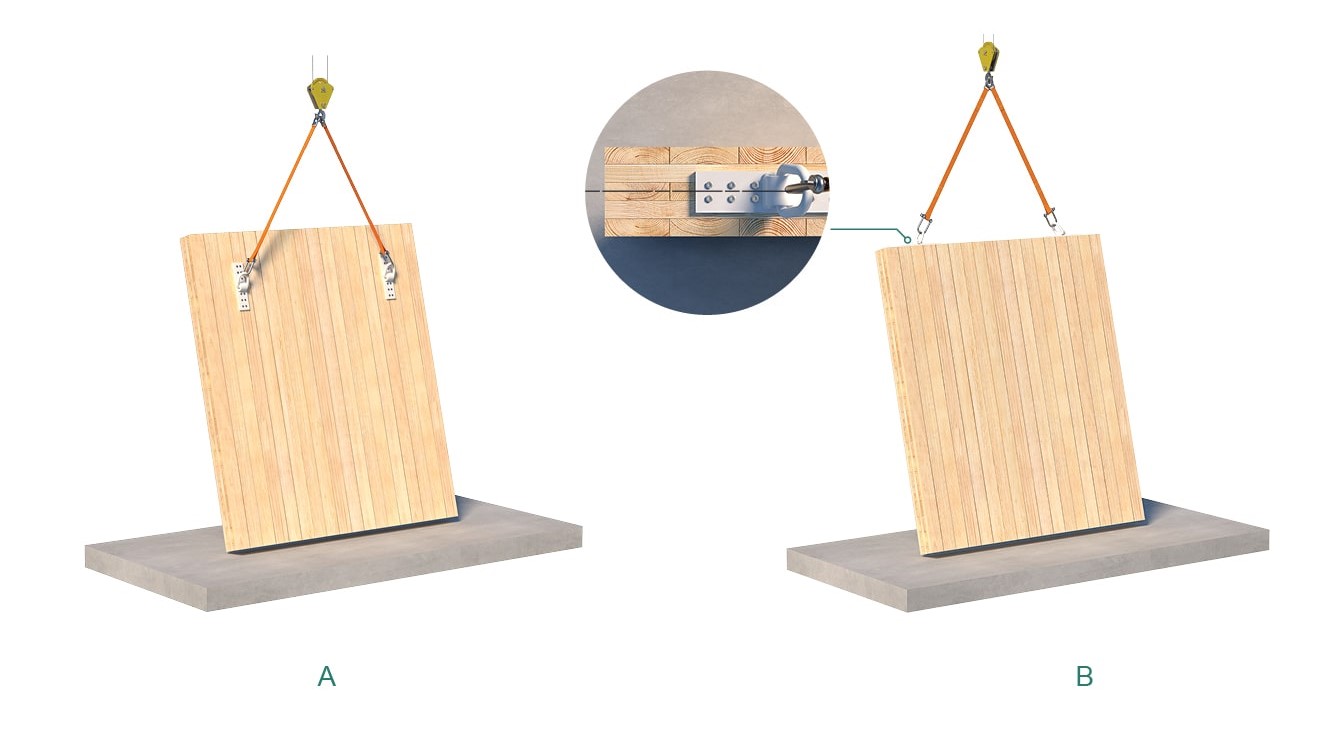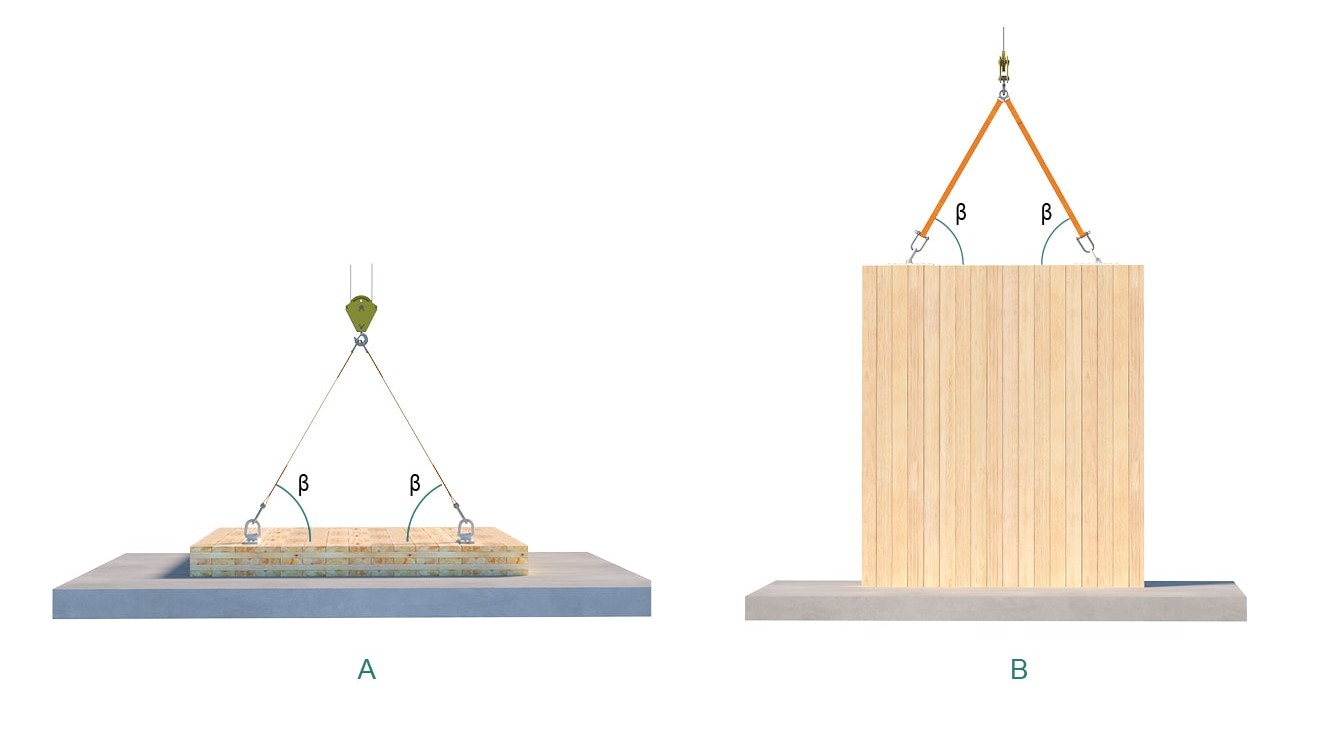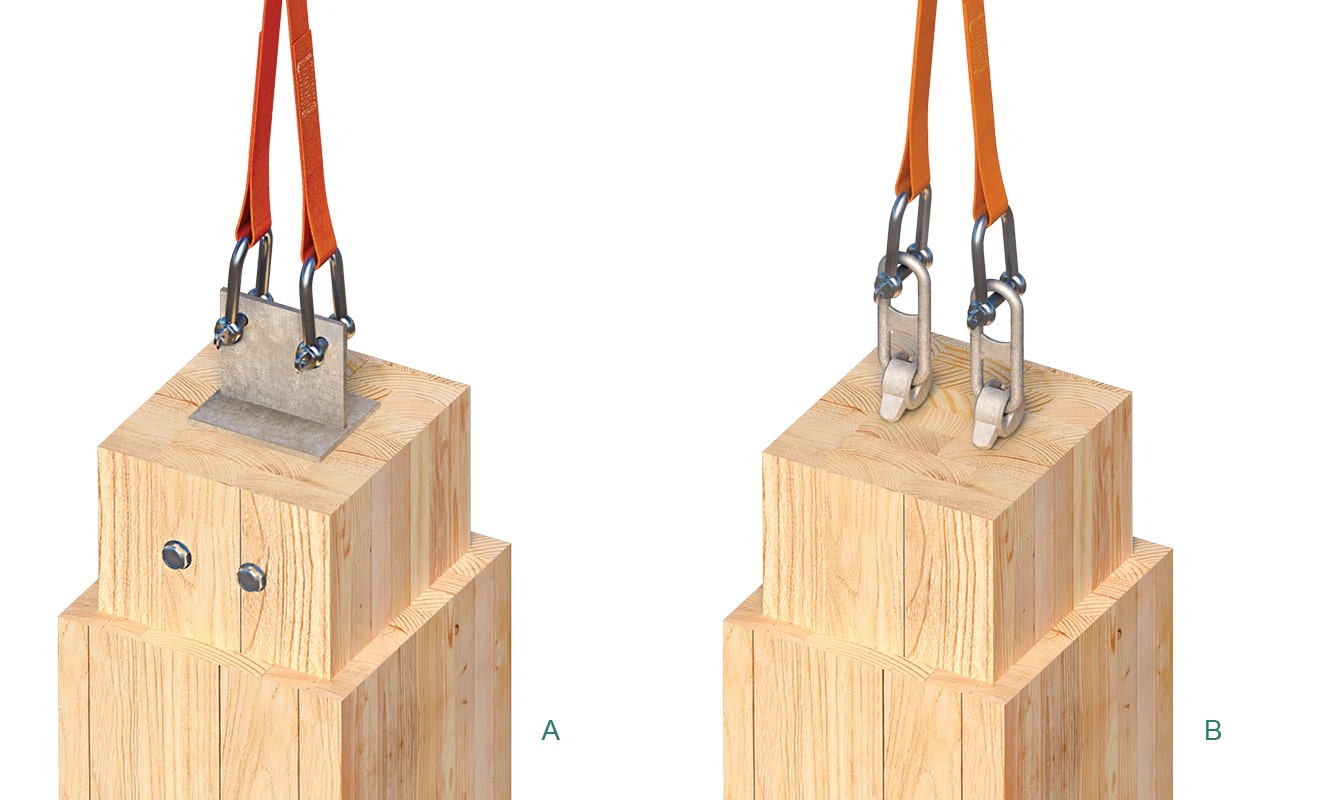While general rigging guidelines—like those detailed in our previous articles, “Rigging Device Installation: Essential Tools and Top Tips” and “How to Ace Rigging Safety Checks: Simple, Efficient, Proven Steps”—are often sufficient, certain scenarios in mass timber projects require specialized approaches. In this article, we explore three unique rigging cases you might encounter: wall panel tilt-up, columns, and deep beams.
Read on to learn practical techniques to help you navigate these situations efficiently and safely.
Approximately 7-minute reading time.
Wall Panel Tilt-Up
CLT wall panels can be tilted into place by lifting them from a horizontal to a vertical position. This is usually achieved by attaching anchors to either the edge or the face of the panel at one end, while the other end bears on a stable surface for support.

Figure 1. Anchors installed on the (A) face and (B) edge of a panel in a tilt-up operation
Key Consideration: Sling Angle (β)
The sling angle (β)—the angle between the sling and the panel surface—is key to a safe lift. Maintain β ≥ 60° for optimal sling tension and loading. Here is how to measure it correctly:

Figure 2. Proper methods for measuring sling angle (β) when anchors are installed on (A) the face and (B) the edge
Note: When installing anchors on the edge, place them along the midline to minimize splitting risk (Figure 1B).
Why does β matter? It affects two important factors:
A β below 60° simultaneously increases anchor demand and decreases anchor capacity, making it crucial to properly measure and maintain β ≥ 60°.
For detailed calculations on demand and capacity, consult our Rigging Design Guide (Pages 15–17) or reach out to our Technical Support Team for assistance.
Column Lifting
Lifting columns presents its own set of challenges compared to CLT panels:
These characteristics limit picking points to the top end of the columns. Below are two primary methods for lifting columns:
Using Preinstalled Connectors
Many columns, especially those below roof level, come with a preinstalled column-to-column connector that can serve as a convenient picking point. This method is efficient and straightforward—just make sure a licensed rigging professional verifies the connector’s capacity and factor of safety.
Using Anchors
When preinstalled connectors are unavailable, anchors can be installed on the top end of the column for lifting. There are two types of anchors to consider:
(1) Slide-On Anchors—Transport Anchor
The Transport Anchor is preferable for lifting columns. It slides onto and off of a single Kombi LT screw with a 1/2 in. [ 12 mm ] diameter, allowing for quick installation and removal. This anchor provides adequate capacity for typical column weights. For increased capacity, use longer screws. For added safety, use a second Transport Anchor with a screw inserted at 45°.
(2) Screwed-In Anchors
While capable of higher capacities, screwed-in anchors require at least four screws and often need machinery like scissor lifts for removal. This makes the process more time-consuming and less cost-effective due to increased crane time.

Figure 3. Column rigging using (A) a column-to-column connector and (B) the Transport Anchor
Note: Due to variability in end-grain wood conditions at column ends, tabulated data is not typically provided for rigging columns. While custom column yokes have been designed for specific projects, generalized values are unavailable. For projects involving extensive column rigging, contact our Technical Support Team to develop a tailored, controlled rigging solution.
Deep Beam Rigging
When slings are not an option, we recommend the Yoke XL, our heavy-duty anchoring system, for lifting deep beams. In this application, perpendicular-to-grain tension remains a main concern due to its potential for causing splitting.
Solution: Use the longest possible fasteners to ensure strong thread engagement in the deeper laminations of the beam.
Note: Longer fasteners can shift the governing capacity from withdrawal to tension. Tension has a factor of safety of 3, while withdrawal has a factor of safety of 5, aligning with guidelines such as those from OSHA, IHSA, and Worksafe BC. Tabulated design values guarantee an adequate factor of safety for the connection from the anchor to the beam but do not account for splitting forces under the screw tips.

Figure 4. Deep beam rigging (A) with and (B) without reinforcing screws
Solution: Consider using tabulated design values where applicable and adding reinforcement with ASSY VG CYL or RH fasteners around the picking points to mitigate splitting. The reinforcing screws can resist splitting forces across their entire length. They should be installed in such a way that the forces are carried through the entire beam depth.
If you have any questions about our rigging systems or need help with rigging planning, contact our Technical Support Team 😉.
Register for a Technical Learning Session
Sign up for MTC Newsletter and keep up to date with all our progress.